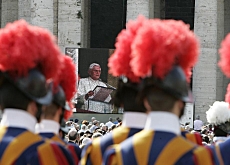Einsiedeln monastery moves with the times

A huge building with a baroque façade, the imposing Einsiedeln monastery is one of Switzerland's oldest and most important places of pilgrimage.
The cloisters are still very active. More than 80 Benedictine monks live there, organising pilgrimages, teaching in the school and even playing the starring role in the local play.
The square in front of the more than 1,000-year-old monastery is currently doubling as a stage, where the residents of Einsiedeln have been performing their “world theatre” play.
This tells of the end of the world mostly brought about by human neglect of the environment.
It is perhaps a testament to how strongly linked the village is to its monastery that the leading role of “the world” is played by a monk.
“Einsiedeln is the biggest baroque and Benedictine monastery in Switzerland,” Urs Raschle, head of Einsiedeln Tourism, told swissinfo.
“It is one of the most important monasteries, and the abbot’s opinion has a lot of weight. He is also a bishop and was nominated to this position by the Pope,” he added.
Raschle estimates that 800,000 to one million pilgrims come to the site every year. Many stop over while following the St James’ Way down to Santiago de Compostela in Spain.
People come to pray in the church, whose sumptuous interior is decorated in an extraordinary mix of pastel pinks, greens and gold, as well as frescoes.
Black Madonna
For many, the focus of their visit is the Black Madonna. The statue, which dates from the 15th century, originally turned black through dust and soot from candles, oil and incense.
An attempt to clean her so upset the locals that her face and hands were painted black in 1803.
Her appeal extends to other religions as well, such as the Hindu Tamil community.
“Tamils come from Switzerland and its surroundings to pray, and especially after the [2004 Indian Ocean] tsunami, this was a really important place for them,” said Raschle.
The story of Einsiedeln began in 835, when St Meinrad, a Benedictine monk from Lake Constance, came to live as a hermit at the site. Other monks followed and after St Meinrad’s murder, the first church was built on the site in 934.
According to legend, two ravens followed the murderers until they were apprehended. The birds are remembered in the monastery’s coat of arms.
The abbey became known as a place of pilgrimage. During the Middle Ages, its influence extended as far as southern Germany and upper Italy.
It entered its golden age in the baroque era, when the buildings were greatly extended and rebuilt in their present style.
Monastery life
A visit to the monastery proves that it is still very active. A monk sets up the projector for the introductory film about the site. We hear how the abbot, Martin Werlen, is rumoured to use a scooter to negotiate the 150-metre corridors.
But Einsiedeln is facing a severe drop in numbers, although there are currently three junior monks.
“When I entered the cloister a good 50 years ago there were 204 monks. Today we are around 80, so our individual duties have become smaller,” Father Othmar, who lives at the monastery, told swissinfo.
He added that the community tried to face these challenges through worship and through work, an important part of St Benedict’s teachings.
The cloister school remains an important focal point, as do the pilgrimages. But Father Othmar, who used to organise the pilgrimages, says even these have changed, becoming more international and focusing on individuals rather than large groups.
“But the duties associated with pilgrimages to Einsiedeln are still the same as they were 400-500 years ago, namely to try to direct the pilgrims we meet to Christ through Mary, mother of God,” he said.
swissinfo, Isobel Leybold-Johnson in Einsiedeln
Key dates:
835: St Meinrad comes to the Dark Forest
861: St Meinrad killed by robbers
934: First Benedictine monastery founded
1073: The name “Einsiedeln” (from the German word for hermit) appears
1704: Rebuilding begins
1798: The French occupy Einsiedeln
19th-20th centuries: Monastic foundations made in North and South America
1984: Pope John Paul II visits
The Einsiedeln World Theatre runs until September 8, 2007. The village has been performing a play in front of the monastery since 1924. The last staging was in 2000.
Normally the villagers perform Spanish writer Calderón’s world theatre play from 1635. But this year the theatre is showing a modern reworking of the play by Swiss author Thomas Hürlimann.
The last event attracted around 70,000 people.

In compliance with the JTI standards
More: SWI swissinfo.ch certified by the Journalism Trust Initiative













You can find an overview of ongoing debates with our journalists here . Please join us!
If you want to start a conversation about a topic raised in this article or want to report factual errors, email us at english@swissinfo.ch.